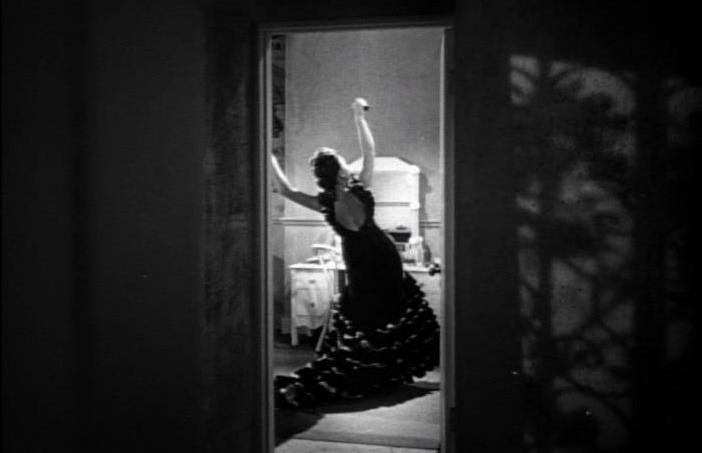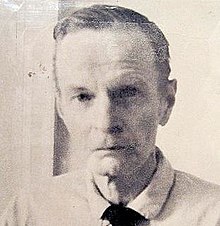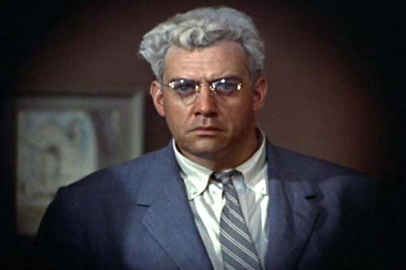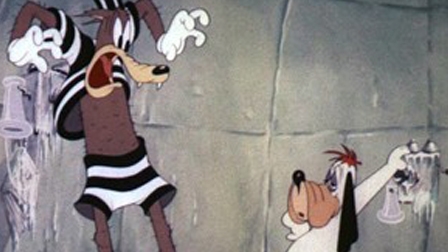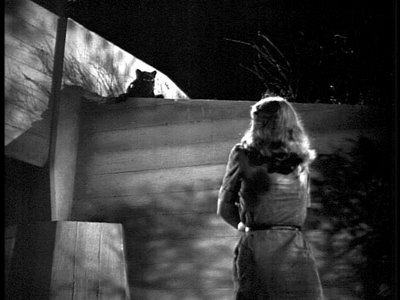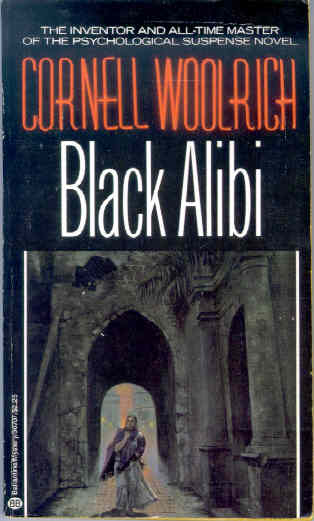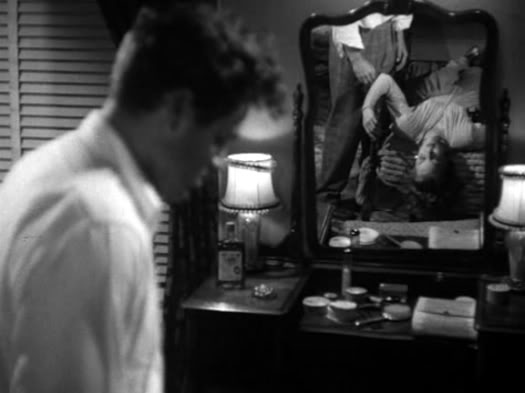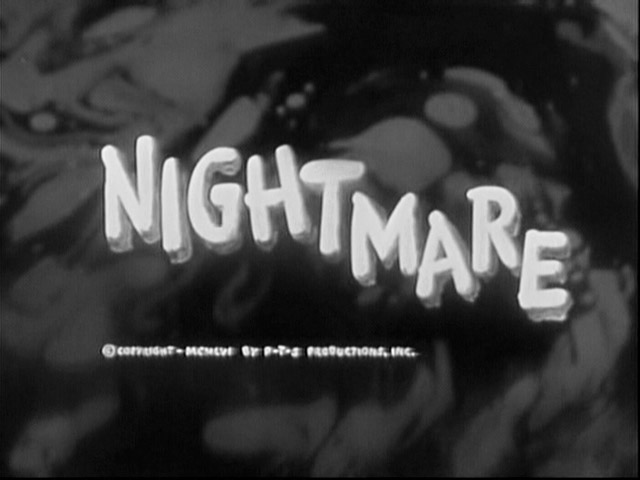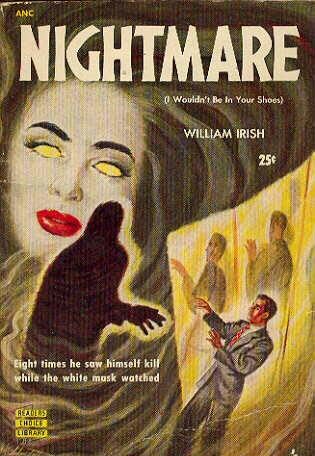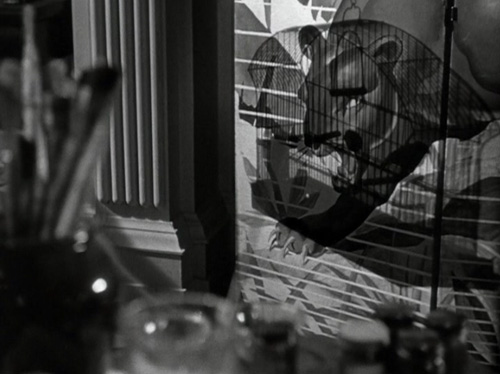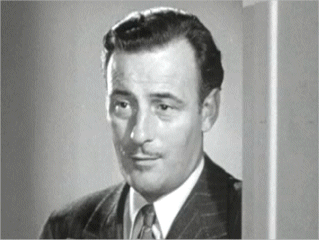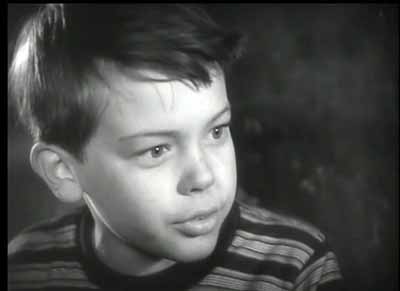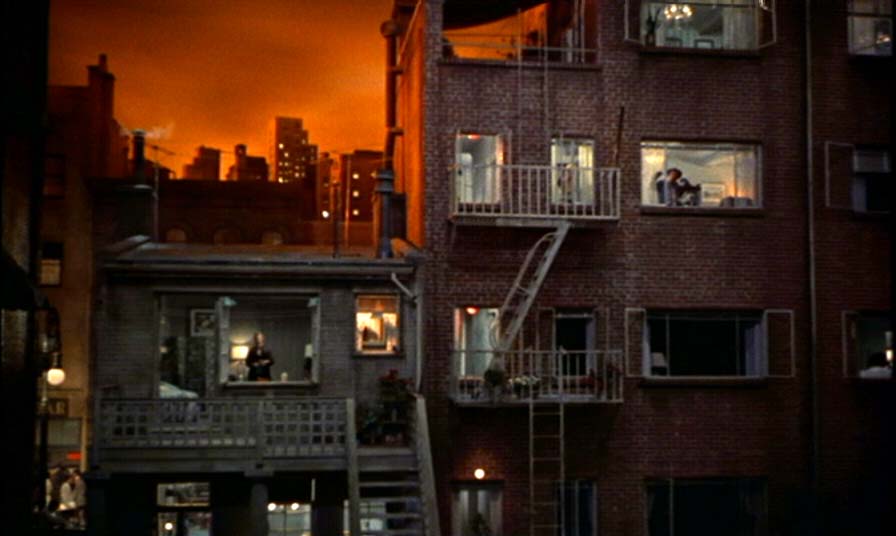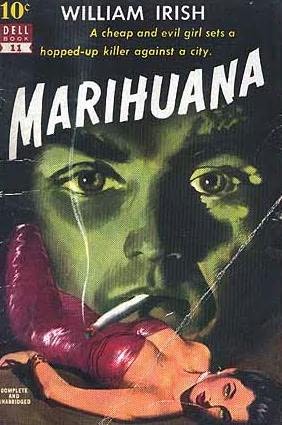From Film Comment, September-October 1984. — J.R.
Rear Window, The Leopard Man [see first two photos above], Phantom Lady, The Window, The Bride Wore Black, Mississippi Mermaid. Considering that almost 30 features have been Cornell Woolrich adaptations, it seems a genuine anomaly that he should remain so shadowy a figure. He is as central to the thriller as Olaf Stapledon is to science fiction, and has been comparably eclipsed by a singularity that exceeds and surpasses some genre expectations while grievously falling short of certain others. Despite all the purple prose, tired rewrites, and preposterous plots that crop up in his fiction, perhaps no other writer handles suspense better, or gives it the same degree of obsessional intensity. More soft-boiled than hard-boiled in the depiction of his heroes and heroines, Woolrich nonetheless seems central to the overall pessimism of film noir in the violent contrasts of his moods and the dark tempers of his villains.
Webster’s New Collegiate gives three definitions of dreadful: “(1) (adjective) inspiring fear or awe, (2) (adjective) distressing, shocking; very distasteful, (3) (noun) a morbidly sensational story or periodical; as, a penny dreadful.” Woolrich assumes all these meanings and invents a few more of his own. As a master of dread (rather than of character, atmosphere, plot, or prose), he has conceivably no pulp equal. In the checklist appended to Nightwebs -– an excellent collection of Woolrich stories and an ideal introduction to his work –- Francis M. Nevins, Jr., lists 22 novels under Woolrich’s name, 17 more under the pseudonym William Irish, two more as George Hopley (including one of the most memorable, Night Has a Thousand Eyes), hundreds of stories, and scores of scripts for film, TV, and radio. The variations in quality, as one might suspect, are enormous, but the closest thing to a common denominator is the excruciating sense of dread.
For a long time, I couldn’t understand why jacket photos of Woolrich were so scarce -– until I finally came across one, on a hardcover edition of Nightwebs. It’s the face of someone who appears never to have seen daylight, a slab of putty so riddled with anguish that an infinite number of nightmares could be extrapolated out of it. Among the images in film adaptations of Woolrich, only Raymond Burr’s tortured expression under the glare of James Stewart’s flashbulbs at the climax of Rear Window comes close to evoking as much disquiet. A recluse who was morbidly attached to his mother for most of his adult life, Woolrich became a diabetic and an alcoholic after her death in his mid-fifties. When he died of a stroke at 64 in 1968, he had already lost a leg due to the spreading of gangrene.
Direct acknowledgment of Woolrich’s homosexuality has apparently made it into print only recently –- see Nevins’ introduction to Manhattan Love Song (Gregg Press, 1980), an early novel preceding the thrillers –- and inevitably leads to a somewhat different reading of his fiction, clarifying an impulse that up to now has received little attention. Ernest Hemingway’s prose often bristles with the threat of hysteria, but is almost always held in check by the code of macho rectitude that keeps it from fully busting loose. Josef von Sternberg’s fear of losing emotional control haunts his découpage like a fishnet or a shadow; there are moments in The Blue Angel and Anatahan when masculine hysteria finally bursts out onto the placid surface of his compositions, turning them into gaping Goyas. Woolrich, a more intermittent artist, expresses hysteria almost nonstop. He can give it a sexual undertone without ever making its meaning strictly gender-based, as it is so frequently in Poe and Hemingway, Sternberg, and Peckinpah. His heroines tend to be phallic while his heroes often verge on being sissies –- and fear becomes the democratic, universal plane on which they can meet as equals.
***
Despite all the film adaptations of his work, Woolrich’s own minimal contact with filmmaking preceded his writing of thrillers, which began in 1940 with The Bride Wore Black. His second novel, Children of the Ritz (1927), won a prize in a contest cosponsored by First National Pictures, and he was invited to come to Hollywood from New York in 1929 to help with the film adaptation. (A title and dialogue writer for First National at the time was named William Irish, and Nevins ascribes Wollrich’s later adoption of the name as a pseudonym to this fortuity.) The following year, he eloped with Gloria Blackton, daughter of the founder of Vitagraph Studios, although reportedly the union was never consummated. Woolrich returned to New York shortly afterward, and the marriage was later annuled.
Ironically, some movies that ostensibly have nothing to do with Woolrich — Vertigo, Psycho, Brian De Palma’s Obsession, Detour, The Seventh Victim, Jacques Tourneur’s Cat People, François Truffaut’s The Green Room, even Tex Avery’s Dumb-Hounded — impart more of his compulsive flavor than certain oddball adaptations, such as The Bride Wore Black, Mississippi Mermaid, Night Has a Thousand Eyes, and I Married a Shadow. Tom Milne has nominated Jacques Rivette as the ideal Woolrich adaptor because of his handling of paranoia — an interesting notion, but ultimately a misleading one. In Rivette’s work, paranoia finds a social meaning by being bracketed by a leftist, modernist, or post-modernist context. By contrast, the masochistic tone of Woolrich guarantees that every dive into paranoia be interpreted as a fall, and social critique invariably gives way to metaphysics.
Truffaut’s two Woolrich adaptations — both fascinating works in their own right — betray the spirits of their originals by attempting to reconcile Hitchcockian moods and structures with Renoiresque details. Part of the difference is the casting. If Jeanne Moreau (Julie Kohler in The Bride Wore Black) and Catherine Deneuve (Julie Roussel in Mississippi Mermaid) had switched parts and films, and Truffaut himself had taken over Jean-Paul Belmondo’s part in the latter, the resulting dynamics would have more nearly matched the original novels.
Waltz into Darkness (1947), the source of Mermaid, carries the theme of a man’s obsession with a femme fatale to such irrational extremes that it is hard to think of any director less obsessed than Woolrich bringing it off. The relative absence of suspense doesn’t prevent it from being one of my two favorites — along with the equally mad Night Has a Thousand Eyes, which breaks as many generic rules, and by contrast may have the most sustained suspense of any of the novels, although it paradoxically makes that achievement monotonous through endless elaboration and extension.
A characteristically insane detail from the latter novel: the sympathetic, devoted daughter of a man who’s awaiting his prophesied death around the clock, for weeks on end, secretly sets all the clocks he’s surrounded himself with back a couple of minutes. “That gives him a minute or two extra,” she explains, “a little borrowed time, it’s the best I can do to ease him.” If the John Farrow film had dared to be as demented as that, it might have worked the maximum out of John F. Seitz’s luscious noir photography, an interesting Edward G. Robinson performance, and the superb Langian title. As it stands, the drastic plot reshuffling in the script by Jonathan Latimer and Barré Lyndon compromises Woolrich’s delirium by diluting it.
The most extreme instance of dissolving Woolrich, however, comes in Robin Davis’ recent I Married a Shadow, which turns the better-titled I Married a Dead Man into a soppy piece of French bourgeiois uplift out of Diane Kurys, and in the process forfeits Woolrich’s magnificent if implausible horror ending. Even the extraordinary The Leopard Man, which in individual scenes and moments perfectly catches the terror of Black Alibi (1942), finally winds up doing something less focused, though compelling enough on its own terms.
The lesson in all this is that you rationalize Woolrich’s ridiculous plots at your peril. In the Truffaut adaptations, Deneuve and Belmondo are simply too charming to qualify as Woolrich monsters, and Moreau is too chic; the value of these movies must be found elsewhere. The sustained perversity of Waltz, actually much closer to Dostoevsky than to James M. Cain, is something that Truffaut can only hint at — in a series of sorties and retreats that anticipate the cautionary measures of The Story of Adele H. It isn’t until The Green Room (based on two Henry James stories) that the crazed Woolrichian protagonist finally gets a movie shaped to his or her sensibility, with Truffaut himself portraying a morbid hero who lives only for the deceased — in particular his wife Julie (a significant name for Truffaut as well as Woolrich), dead at 22. The film itself goes nuts in typical Woolrichian fashion; it builds a mausoleum around Truffaut’s tortured cinephilia, with Nestor Almendros’ cinematography elegantly dressing the corpse. Edgar G. Ulmer’s Detour (and, to a lesser extent, Maxwell Shamne’s Nightmare, which actually adapts a Woolrich story), evokes the overall forlornness of a Woolrich plot, enhanced by a mangy, minimal budget.
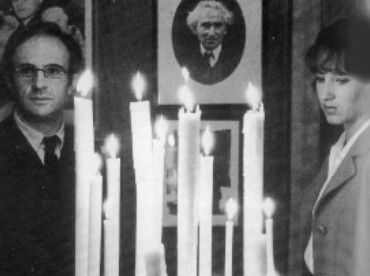
***
Tourneur’s Cat People takes over a basic Woolrich strategy — irrationality triumphant — and subtly makes it modernist by assigning all the neat Freudian explanations of its troubled heroine to a psychiatrist, and then discrediting him immediately through his own crude sexual interest in her. (The same character — Dr. Judd, played by Tom Conway, the older brother of George Sanders — turns up in the equally brilliant The Seventh Victim.) In his lamentable remake of Cat People, Paul Schrader assumes that the shrink is correct, eliminates him from the plot, and then imposes him more insidiously (as Dr. Schrader) on the mise en scène — making garishly literal and banal everything that Tourneur wisely kept latent as poetic postulate. (In his script for Obsession, however — admittedly shortened by Brian De Palma, at the behest of Bernard Herrmann — Schrader at least knew how to sustain a mood of Woolrichian hopelessness.) Waltz may well be a working through by Woolrich of his doomed relationship with his mother, but if he had approached the theme therapeutically, after long sessions on the couch, I doubt that it would have registered as strongly.
I haven’t been able to track down the 1947 Woolrich story “The Boy Cried Murder,” reprinted as “Fire Escape,” which forms the basis of Ted Tetzlaff’s The Window, but according to Foster Hirsch’s description in The Dark Side of the Screen, it sounds pretty close to the film. A powerful and neglected film noir, The Window makes an effective companion piece to Rear Window (based on the 1947 Woolrich story “It Had to Be Murder”). Both films offer near-definitive impressions of New York during the summer, and both revolve around the consequences of someone accidentally and elliptically glimpsing a murder in a neighboring apartment.
In The Window, it’s Bobby Driscoll, a boy sleeping out on a fire escape because of the heat. He has a reputation for telling tall tales to his parents, so no one believes him — except for the murderers themselves, who gradually close in on him. James Stewart, a photojournalist in Hitchcock’s Rear Window, sees what appears to be the aftermath of a murder on the other side of his courtyard, and his own helplessness is ensured by having his leg in a cast. In both cases, the plot operates like a descending whirlpool, with the immobilize hero caught in the center — a classic Woolrichian setup.
As Hirsch points out, “The Woolrich world is a maze of wrong impressions as the author sets traps for his luckless protagonists and then watches as they fall into them.” Perhaps because Woolrich identified with his protagonists so passionately, he offers in his work a searing account of self-flagellation that more than a half-century of moviemaking has capitalized on, and imprinted on our worst dreams.
— Film Comment, September-October 1984; slightly revised, February 2010 and February 2018

